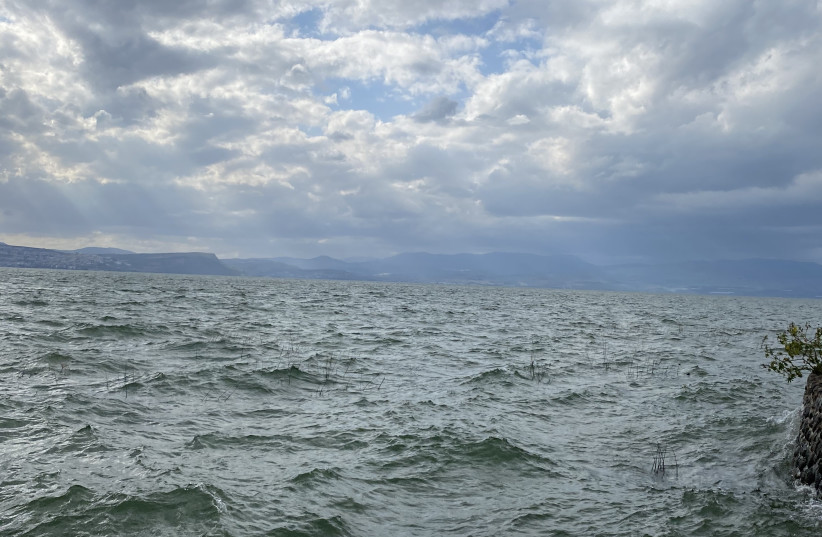For most of Israel’s 74 years, its citizens have had to keep a watchful eye on the water levels of Lake Kinneret, otherwise known as the Sea of Galilee. It was far and away the main source of the nation’s drinking water, supplemented only by a couple of aquifers and a few regional resources.
The Kinneret is the lowest freshwater lake in the world. When full, it sits 208.8 meters below sea level. If it rises any higher, the Deganya Dam, located to the south of the lake, is opened to avoid the flooding of the surrounding areas. This last occurred partially in May 2013, when millions of cubic meters of water were diverted from an overflowing Kinneret into the Jordan River.
Until 1998, the normal weather pattern ensured that winter rains over the six months October-March, and the melting snows on Mount Hermon in the spring, fed Lake Kinneret year by year. Then came the drought that affected Israel between 1998 and 2001, the most severe in 125 years. In 2001 the lake level fell to 214.9 meters below sea level, the lowest in recorded history and well below what is known as the “lower red line,” which has been set at 213 meters below sea level. That is considered dangerously low and ecological damage starts to occur, water quality declines, and pumping from the Kinneret is forbidden. At its critically low level in 2001, the Deganya Dam threshold was higher than the level of the Kinneret.
The following years saw only a moderate return to normal weather patterns. Another bad year was 2004, and an even more severe drought hit again in 2008 when Kinneret’s water levels saw the sharpest drop since measurements were first recorded. By October the level was again well below the lower red line as Israel was in the throes of another major water shortage crisis. Public anxiety rose, and news broadcasts began including the latest Kinneret level in their bulletins.
All that is history. Over the past 15 years, by dint of a concerted governmental and scientific effort and the successful application of advanced technology, Israel has not only become entirely self-sufficient in meeting its water needs, but is actually producing an annual water surplus that it has begun exporting. Toward the end of 2021, the government signed a water-for-energy deal with Jordan, under which Jordan will export solar power to Israel and Israel will provide some 50 million cubic meters of water each year to Jordan.
How has this extraordinary turnaround been achieved?
Between 2005 and 2015, Israel changed its entire water system by building desalination plants that provide drinking water to the highest standards. Instead of reliance on the Kinneret, Israel now receives over 80% of its drinking water from the sea. The Western Galilee water desalination plant, the seventh to be built south of Nahariya, is scheduled to be up and running in 2025. It will provide the residents of Galilee with about 100 million cubic meters of desalinated water.
Israel’s desalination technology is being exported across the world. Southern California, for example, is using an Israeli designed and operated desalination plant, completed in 2015, which currently provides the greater San Diego area with 10% of its daily drinking water.
But desalination is only one aspect of Israel’s advanced water technology. Israel also leads the world in wastewater recycling, transforming an environmental problem into a resource. About 86% of all Israel’s wastewater is recycled and then used for agricultural purposes. Water-efficient farming is becoming ever more important in the face of climate change, and drip irrigation, one of whose components is recycled wastewater, is a major Israeli contribution to world agriculture. The Israeli firm Netafim, which started life in 1965 in the Negev, now exports Israeli precision irrigation techniques across every continent. Each year the organization runs more than 350 projects in more than 40 countries. Gabriel Miodownik, CEO of Netafim, has explained that precision irrigation, using recycled and saline water, increases water efficiency for farmers by 50% compared with other irrigation methods.
Then there is the almost miraculous atmospheric drinking water (AWG) technology, devised by the pioneering Israeli company Watergen, which creates high-quality drinking water from air. AWG units use humidity in the air to bring affordable, clean and fresh drinking water to people across the world. Watergen has donated countless solar-powered water-making machines to places facing a water crisis. During California’s most destructive wildfire ever in November 2018, Watergen AWG technique literally pulled drinking water out of thin air to serve the teams of firefighters and keep them on the job.
Israel is also in the lead in the technique of accessing water from deep in the ground. Innovation: Africa is a non-profit organization that brings Israeli solar, water and agricultural technologies to rural African villages. Using Israeli solar and water technology, it delivers access to clean water and light to nearly three million people across 10 African countries. By installing solar panels, water can be accessed from deep in the ground through an electric pump. This frees up hours each day for women, who no longer need to walk for miles to access water for their families.
After a slow start, the winter of 2021-2022 has turned into another rainy season doing its best to fill Lake Kinneret to the brim, with the day-by-day water level creeping up inexorably toward the upper red line. With February and March, the tail-end of the rainy season, still to deliver their weather, opening the Deganya Dam is becoming a real possibility. But the fluctuating fortunes of Lake Kinneret have changed. Gone is the national concern about what, if anything, might result from turning the faucet – or, in Brit households, the tap. The citizens of Israel are now assured that top-quality drinking water will always flow, most of it having started its journey in the Mediterranean.
In short, we can all forget about the levels of the Kinneret and concentrate instead on the spectacular beauty of the lake and its environment. A visit to the Kinneret, and a meal at one of its lakeside restaurants of grilled St Peter’s Fish, the special denizen of the Sea of Galilee, is a delight to be treasured, or, if not yet experienced, to be anticipated with much pleasure. ■

